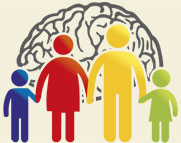Parents often wonder whether their child is acquiring language at a normal rate. According to the American Speech-Language-Hearing Association (ASHA), communication skills begin to develop in infancy, well before a child speaks his/her first word. The development of speech and language skills is crucial, and children who exhibit any speech or language delays or problems are often likely to experience an impact in the development of their social, academic, and/or behavioral skills. Because of the large positive impact of early intervention on the development of speech and language, caregivers should be aware of the average speech and language milestones so that their child(ren) can benefit from early intervention if needed.
Below is a summary of common developmental milestones identified by ASHA during the first three years of life for children exposed to a single language (monolingual). Children should master most skills within an age range by the end of that range. Missing a single skill should not cause great concern.
- Birth-6 months hearing/understanding: startles to sounds; quiets or smiles when spoken to; appears to recognize caregiver’s voice; moves eyes in direction of sounds, notices toys that make sounds.
- Birth-6 months talking: makes pleasing sounds such as cooing and gooing, emits different cries for different needs, smiles, babbling, laughing, gurgling sounds, vocalization of excitement and displeasure.
- 7 months-1 year hearing/understanding: enjoys peekaboo, looks in direction of sounds, recognizes words for common items, begins responding to basic requests.
- 7 months-1 year talking: babbling with both long and short groups of sounds, uses speech to get and keep attention of caregivers, uses gestures to communicate wants, has one or two words around first birthday.
- 1-2 years hearing/understanding: can point to several body parts, follows simple commands, listens to songs and stories, points to pictures in a book when object is named.
- 1-2 years talking: increases words each month, uses one- or two-word questions, can put two words together.
- 2-3 years hearing/understanding: understands differences in meaning, can follow two requests, enjoys hearing stories for longer periods of time.
- 2-3 years talking: has a word for most everything in immediate life, uses 2- and 3-word combinations, speech is understood by familiar listeners most of the time, asks for objects by naming them.
Talk with your child’s pediatrician if you have any concerns regarding speech/language development. You can also directly contact a professional to discuss communication and other concerns that may need to be evaluated to determine the need for early intervention services, which are crucial for improved outcomes.
Contact us for more information about this and other topics.
Written by Olivia Puyana, Ed.D., NCSP
Photo Credit: Freerange



